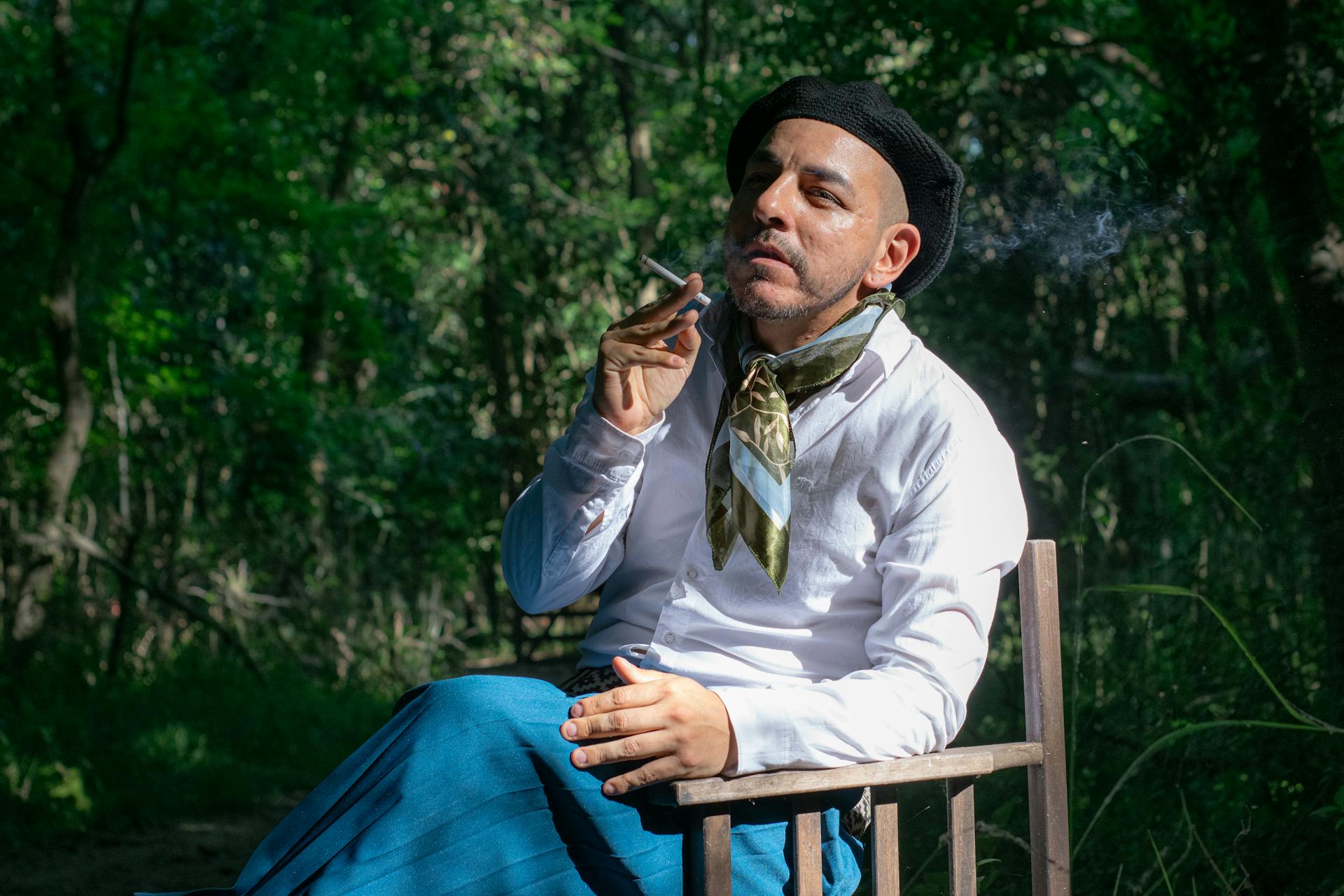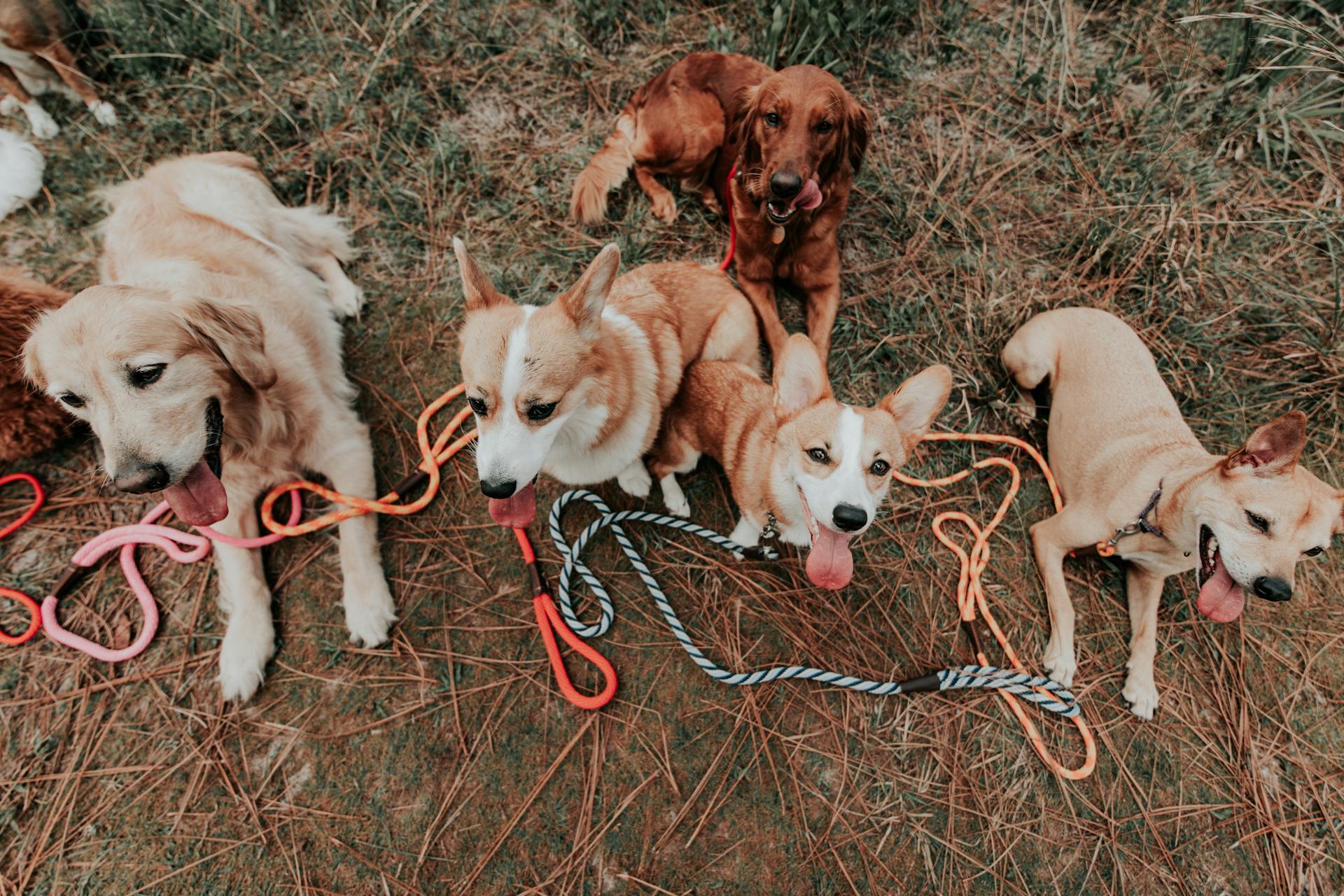
The Argentino Dogo is a rare breed, but with the right care and attention, it can make a wonderful companion. This breed is known for its short, smooth coat that requires minimal grooming.
They are a medium-sized dog, typically weighing between 80-120 pounds. Their muscular build and athletic ability make them a great fit for active families.
To ensure your Argentino Dogo puppy gets the exercise it needs, consider enrolling in puppy classes or hiring a dog walker. This will help burn off excess energy and prevent destructive behavior.
Argentino Dogo puppies are known for their strong prey drive, so be prepared to provide plenty of toys and chews to keep them occupied.
Expand your knowledge: Dogs Breeds That Start with B
Origin and History
The Argentine Dogo has a rich and fascinating history that dates back to the 1920s in central Argentina. Antonio Nores Martinez, a young student of Córdoba, set out to create a new breed of big game hunting dog, especially wild boar.
He started with a Bull Terrier bitch with considerable fighting ability and bred her to a spotted fighting dog of bulldog type. This was the beginning of the Argentine Dogo breed.
The breed was developed to have the fighting qualities of the Old Cordoba Fighting Dog, but with greater size and strength. Antonio Nores Martinez selected and inter-bred their offspring, selecting for white coat colour and rejecting any animal that was retrognathous.
By the twelfth generation, his dogs were breeding true and became well known for their success in the ring. Nores Martinez later introduced crosses with a variety of other dogs, including the Irish Wolfhound, Boxer, Great Dane, Bull Terrier, Dogue de Bordeaux, and Spanish Mastiff.
The breed was presented to the Club de Cazadores in 1947, and a breed standard was published in the magazine Diana in 1948. The Dogo was definitively accepted by the Fédération Cynologique Internationale in 1973.
Here are some key events in the history of the Argentine Dogo breed:
- 1920s: Antonio Nores Martinez begins developing the Argentine Dogo breed.
- 1947: The breed is presented to the Club de Cazadores.
- 1948: A breed standard is published in the magazine Diana.
- 1973: The Fédération Cynologique Internationale definitively accepts the breed.
Care and Upkeep
The Dogo Argentino is a robust dog that needs plenty of exercise, so make sure to take it for lots of walks and keep it mentally challenged.
You'll want to provide a secure fenced yard for your Dogo to run around in, supplemented with leash walks and other activities like games, agility, and obedience training.
The Dogo enjoys playing with a ball or a disc, but it may not retrieve them, so be prepared for a fun game of catch.
Coat care is minimal, consisting of occasional bathing and brushing, but don't forget to brush its coat several times a week to remove dirt and dead hair.
As a breed susceptible to canine hip dysplasia, it's essential to feed your puppy a large-breed puppy food to slow down its growth and reduce the risk of dysplasia.
Pigment-related deafness is a common issue in the breed, so it's recommended to perform brainstem auditory evoked response (BAER) testing on all puppies to evaluate their hearing.
Here's an interesting read: Bernese Mountain Dog Hip Dysplasia
The Dogo Argentino is not suitable for dog parks due to its potentially aggressive nature, so it's best to socialize it with other dogs in a controlled environment.
A hearing test should be carried out on puppies after six weeks to detect congenital deafness, which is common in this breed.
Temperament and Behavior
The Dogo Argentino is a breed that demands respect and attention from its owners. They require an experienced owner who is firm, confident, consistent, and careful, as they can be aggressive toward strange dogs and people.
Early socialization is crucial for this breed, as they may be aloof with strangers until they learn the stranger is no threat. They need to learn to distinguish between friends and foes, and this process should start from an early age.
Dogo Argentinos are loving, loyal, and demonstrative companions that thrive on close contact with their owners. They make excellent watchdogs due to their loyalty and protective nature.
Consider reading: Are Portuguese Water Dogs Good for First Time Owners
These dogs are not prolific barkers, but they will alert you to something they feel is suspicious or not sure about. They have a strong instinct to protect their humans and property.
As powerful hunters, Dogo Argentinos require activities to keep them occupied and happy. They are serious athletes with solid and powerful physiques, and they do best when given plenty of exercise and mental stimulation.
Given their large size, supervision is always recommended, especially around toddlers. They can be standoffish with children if not properly socialized, but with early socialization, they can get along well with kids.
Characteristics and Traits
The Argentine Mastiff, also known as the Dogo Argentino, is a large breed with a shoulder height of around 60 to 70 centimeters and a weight of 40 to 50 kilograms.
They have a short, white coat with a black nose and dark eyes, indicating they are not albinos. However, some specimens may have dark patches on the coat of the head, but the head must be at least 90% pure white according to the breeding standard.
For more insights, see: Dark Rhodesian Ridgeback
The breed is known for its athletic build, with a long sabre tail and a large, massive head. They are also known for their open, friendly, and playful nature, making them a great addition to families with children.
The Dogo Argentino was originally bred as a hunting dog, and this instinct is still present in the breed today. They are skilled hunters, able to stalk their prey silently and display a pronounced intention to kill when hunting.
Characteristics
The Dogo Argentino is a large dog, weighing between 40-50 kilograms and standing at a shoulder height of around 60 to 70 centimeters.
They have a short, white coat that's a crucial breeding characteristic, although some specimens may have a small dark patch on their head. A dark pigmentation of the skin is also characteristic of the breed.
Their head is quite large and massive, with a base of the ears lying on the side of the head and a tipped ear type shape. Ear cropping is often practiced in this breed, but it's not species-appropriate and is prohibited in many European countries.
Expand your knowledge: Bull Terrier Head Shape

The Dogo Argentino has a long sabre tail and an athletic build, making them a powerhouse canine. They're capable of hunting large game in Argentina's vast terrain.
They're generally open, friendly, and playful in nature, getting on very well with children and making them a great addition to families. However, they do have a strong hunting instinct and a pronounced intention to kill when hunting.
The breed can live for 10 to 12 years with sufficient exercise and good husbandry. They're also highly intelligent, but can be difficult to train due to their strong character and dominant behavior towards other dogs.
For more insights, see: How Strong Are German Shepherds
Three Little-Known Facts About the Dogo
The Dogo is a unique breed with some fascinating characteristics. One Little-Known Fact is that the Dogo's short coat requires minimal grooming.
The Dogo's short coat sheds very little, making it a great choice for people with allergies. This is due to its short, smooth coat that needs to be brushed only occasionally.
Intriguing read: What Kind of Dog Is Max from the Little Mermaid
One thing to note is that the Dogo is a natural guard dog and can be wary of strangers. This is because of its strong instincts and protective nature.
In terms of exercise, the Dogo needs regular physical activity to stay happy and healthy. It requires at least 30 minutes of exercise per day, which can be achieved through walks, runs, or playtime in the yard.
Health and Wellness
The Dogo Argentino is a robust and healthy breed, but they can still develop certain health issues. Hip Dysplasia is one of the potential problems.
Regular exercise is essential for Dogo Argentino puppies. You should take them for lots of walks and keep them mentally challenged. This will help prevent behavioral problems.
A hearing test should be carried out on puppies after six weeks. Congenital deafness is common in this breed.
If you're considering getting a Dogo Argentino, it's essential to familiarize yourself with the potential health conditions. Here are some of the most common ones:
- Hip Dysplasia
- Hypothyroidism
- Gastric dilatation volvulus (bloat)
- Laryngeal Paralysis
The Argentine Mastiff has a short coat, which makes it easy to care for. However, you should still brush its coat several times a week to remove dirt and dead hair.
Training and Pet Care
The Dogo Argentino is a highly intelligent breed that requires a firm owner who can display dominance and leadership for training success. They can be hard to handle for an inexperienced owner due to their high prey drive, strength, and energy.
Coat care for the Dogo is minimal, consisting of occasional bathing and brushing. It does not like extreme cold or extreme heat.
Socialization is crucial for these dogs to be well-behaved, requiring exposure to other animals and other people as early as possible due to their territorial and protective side. Brainstem auditory evoked response (BAER) testing is recommended for all puppies, as pigment-related deafness is reported in the breed.
Training
Training a Dogo Argentino requires a firm owner who can display dominance and leadership, as these dogs can be hard to handle due to their high prey drive, strength, and energy.
They have a stubborn streak, making an assertive owner with experience in positive reinforcement training essential.
Socialization is crucial for these dogs to be well-behaved, requiring exposure to other animals and people as early as possible.
This is especially important due to their territorial and protective side.
Owning a Dog
The Dogo is not a dog for dog parks due to its potentially aggressive nature.
It needs frequent exercise, which can be aided by a secure fenced yard in which to run.
Leash walks and other activities like games, agility, obedience, scent work, and other activities that engage both its mind and body are also essential.
The Dogo enjoys playing with a ball or a disc, but it may not retrieve them.
Coat care is minimal, consisting of occasional bathing and brushing.
It does not like extreme cold or extreme heat.
As a breed susceptible to canine hip dysplasia, puppies should be raised on a large-breed puppy food, which slows the rate of growth and lessens the risk of dysplasia.
Brainstem auditory evoked response (BAER) testing is recommended for all puppies, as pigment-related deafness is reported in the breed.
Diet and Nutrition
Feed your Argentino Dogo puppy high-quality dog food with high-quality protein that's age-appropriate and breed-size appropriate.
Curious to learn more? Check out: Do German Shepherds Have a High Prey Drive
Make sure the food contains no fillers or artificial ingredients and is approved by the Association of Feed Control Officials (AAFCO) to ensure quality.
These dogs burn excessive energy, so they do well with eating two to three times daily, spread out between morning, noon, and evening.
Follow the feeding guidelines on the package and consult your vet for the correct amount to feed.
Treats should only be fed in moderation and deducted from the basic diet to avoid obesity.
Puppies can be fed 4-6 times a day, and the number of meals should be gradually reduced to 2 per day until the dog is fully grown.
Feed your Argentino Dogo from a slow-feeder dog bowl to slow down the pace and avoid gastric dilatation-volvulus (GDV), also known as bloat.
Worth a look: National American Eskimo Day
Frequently Asked Questions
Are Dogo Argentino dogs legal in the US?
Yes, Dogo Argentinos are legal in the U.S. However, their legality may vary depending on local regulations.
Is Dogo Argentino a good family dog?
Yes, Dogo Argentino can make great family pets for the right owners, being loyal, friendly, and social. However, early socialization and training are crucial to ensure their protective nature is balanced with family harmony.
Featured Images: pexels.com

